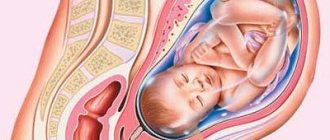When a woman has scanty periods, this condition is called hypomenorrhea.
It has its own reasons, the elimination of which helps to normalize the menstrual cycle. However, to identify them, additional examination is required, primarily hormonal.
- Scanty periods after childbirth
- Scanty periods after a delay
- Scanty periods after curettage
- Symptoms of scanty periods with signs of illness
- Diagnosis of possible diseases
- Treatment of scanty periods
What are scanty periods and why do they occur?
In medical terminology, a name has been coined for this phenomenon. Scanty periods are called hypomenorrhea. Normally, bleeding lasts 3-5 days with an interval of 21-35 days; the amount of blood lost in this case ranges from 50-150 milliliters. Hypomenorrhea is a disorder of the menstrual cycle in which menstrual bleeding is negligible and the amount of blood loss does not exceed 50 ml. Under these circumstances, menstruation usually does not last long (called oligomenorrhea in medical parlance) and risks gradually leading to a complete cessation of periods (amenorrhea).
Hypomenorrhea is considered as a normal option in women during menarche and menopause, and can occur in the first month of pregnancy and during lactation. These periods in a woman’s life are characterized by changes in menstrual function, hormonal changes, and therefore there are grounds for “unusual” vaginal discharge. However, it would be a good idea to see a doctor and rule out pathology.
In other cases, when a woman’s menstrual function has become established and corresponds to certain ideas about stability and regularity, and suddenly menstruation becomes scanty, a number of factors may contribute to this. Scanty periods , according to medical observations, are often the result of dysfunction of the ovaries or pituitary gland; these organs are responsible for regulating menstrual function. Various intrauterine manipulations can also be the basis for changes in the amount of menstrual flow, either increasing or decreasing, because as a result they change the inner layer of the uterus. His own diseases (in particular, inflammatory ones), as well as some systemic diseases, dysfunction of hormonal glands and metabolic processes. The mechanism of development of hypomenorrhea is closely related to the following influences and processes in the body:
- sudden loss of body weight - what happens with anorexia (including nervous), exhaustion, unbalanced and strict diet;
- metabolic disorders and all kinds of diseases of this nature (for example, diabetes or obesity);
- hormonal imbalance due to endocrine diseases, dysfunction of the gonads, temporary external influences on the body (including hormonal contraception);
- violation of blood counts showing the concentration of vitamins and minerals in the body (various hypovitaminosis, anemia);
- neuropsychiatric diseases, severe stress, emotional overstrain - we are talking not only about traumatic negative emotions, but also about shocking pleasant impressions;
- surgical intervention in the genitourinary system, their injury (frequent and/or unprofessional curettage, abortion);
- partial removal of the uterus by surgery and the risk of scarring in the future;
- inferiority of the endometrium of the uterus, endometrial atrophy, adhesions that reduce the area of the endometrium;
- underdevelopment or abnormal development of the female genital organs;
- aggressive infectious diseases of both general and local localization (for example, tuberculosis);
- exposure to external factors - taking certain medications, climate change, excessive exposure to sunlight or abuse of solariums;
- exposure to occupational hazards (radioactive radiation, chemicals);
- intoxication of the body.
The formation of menstrual function in the female body is closely related to the general hormonal background and the production of sex hormones in particular. Violation of the cyclic secretion of hormones leads to insufficiency of the circulatory system in the uterus and defective changes in the endometrium during menstruation. As a result, scanty periods are observed. Scanty periods can occur during periods when there is a certain malfunction in the functioning of the ovaries and pituitary gland, or any other organs responsible for the production of hormones. The hormonal background is a system that is very sensitive to various interactions, reacting with changes to both climatic conditions and external interventions in the body. It is hormonal imbalance that explains hypomenorrhea or other types of changes in menstruation (up to its disappearance) due to abortions and curettage, psychotraumatic effects on a woman, inflammatory and other ovarian diseases. Hormonal levels change during menarche and menopause, in pregnant and breastfeeding women, which means that changes in the menstrual cycle during this period cannot be avoided, but it would not be superfluous to strictly monitor it. If you have the slightest concern, do not neglect the consultation of a specialized specialist.
Main reasons
The following conditions cause strong, intense discharge:
- Diseases of the reproductive system. Inflammatory - endometritis, adnexitis, salpingoophoritis, tumors - uterine fibroids, ovarian cysts, polyps. Endometriosis, adenomyosis, and cervical erosion cause disruption.
- Pregnancy related. These include: threatened miscarriage and miscarriage, ectopic pregnancy, condition after surgical abortion, natural childbirth, cesarean section.
- Use of contraception. The installed IUD, intrauterine device, and taking oral contraceptive pills affect menstruation.
- Taking medications - anti-inflammatory, hormone-containing, anticoagulants, antiplatelet agents.
- Blood diseases. Problems with clotting are caused by very strong, non-stop periods.
- Pathologies of the endocrine system - problems in the functioning of the thyroid, pancreas, obesity.
- Change in body weight. Menstruation is affected by sudden weight gain or loss as a result of unbalanced diets.
- Stress.
Signs of scanty periods
As already mentioned, scanty periods are those in which more than 50 ml of blood was not released during the entire period. Usually this is a daily discharge (over several days or a week) in the form of drops and smearing traces of blood of an unnaturally light or dark brown color.
Hypomenorrhea in its duration can exactly repeat the previously established menstrual cycle, or it can be shorter (extremely rarely longer) than that. In addition to scanty discharge during hypomenorrhea, the following may occur:
- headaches and dizziness,
- nausea,
- pain in the lower back and sacral spine,
- feeling of tightness in the chest,
- constipation and other dyspeptic symptoms,
- weakening of reproductive function and sexual desire,
- sometimes nosebleeds.
What are the additional symptoms?
Symptoms directly depend on the main diagnosis. Sometimes the disorder can be completely asymptomatic. With a small amount of discharge, a woman may notice the following signs:
- discharge in the form of spotting;
- reducing the number of critical days;
- regular headaches;
- nausea;
- painful sensation in the abdomen and lower back;
- disturbances in the digestive process;
- increased sensitivity in the mammary gland.
A woman's libido may decrease.
In the presence of serious illnesses, body temperature may rise, as well as itching and burning in the genitals.
Scanty periods during menarche and menopause
For women who are not of reproductive age, hypomenorrhea is more typical than for others. For young girls whose menstrual cycle has not yet stabilized, as well as for adult women facing premenopause or menopause itself, scanty periods usually do not mean anything more than a change in hormonal levels. During puberty, they occur as part of the development of menstrual function, and during premenopause they indicate the decline of menstrual function. Both at a certain age are completely natural functional changes for the body, and not signs of a pathological condition.
In these cases, hypomenorrhea is quite a physiological condition, but lasting for a fairly limited period of time. In other words, in a young girl, hypomenorrhea should gradually develop into formed periods, characterized by regularity and a certain set of symptoms, and with menopause, hypomenorrhea ends with the cessation of menstrual function. It would be a good idea to be as attentive as possible at this time and not neglect the consultation of a specialized specialist. Medical practice knows a lot of cases where irregular periods remain unnoticed by young girls for many years, and mature women develop gynecological diseases during menopause. Even if this is not directly related to the scanty periods , both menarche and menopause represent a very vulnerable and changeable life period for a girl’s health.
Scanty periods during menarche or menopause should be a reason for an unscheduled visit to a gynecologist under the following circumstances:
- scanty periods of a light color with an increased number of pathological elements - a sign of an inflammatory disease of the genital organs, the color is determined by the content of leukocytes;
- scanty periods of a dark brown color are a sign of injuries and microtraumas of the genital organs, the color is due to the presence of destroyed red blood cells in the secretions;
- scanty periods , accompanied by intolerable pain symptoms, fainting, etc. - requires medical correction in order to facilitate menstruation and eliminate its pathological components.
Reviews
And I still don’t understand why this happens to me sometimes. Moreover, when they are scarce, on the contrary, they last longer for me, up to a week (usually 5 days maximum). Maybe it’s really stress, or maybe some kind of infection. Although she underwent a full examination, no microbes or disorders were found in the genitourinary system. It looks like it’s worth taking up homeopathy, you never know, maybe the doctors didn’t notice something.
I also faced this problem after I stopped taking birth control pills, which I had been taking for 7 years. After the hormonal withdrawal, my periods became irregular, sometimes even once every two months. I was examined by a gynecologist, the doctor said that this could happen after taking birth control for a long time, since the body was accustomed to receiving the hormone for a long time, to rule out other causes, I took tests, did a tomogram of the brain, everything is normal. The doctor prescribed the drug "Cyclodinone", I took it for about three months, the cycle was completely restored.
I have the same thing, only I’m 39 years old - these are all failures in the ovary, from here, naturally, a hormonal imbalance, a lack of hormones, you need to do a blood test, only then they will determine and treat.
Girls, hello! There was a female operation (conization - on the cervix). After a month everything healed, the gynecologist said that the cervix was good... then the first and second periods came after the operation - normal, and in May they started to be scanty... for three days... and yesterday they started... one day and that’s it.... (((no more... I can’t think about anything, only about them... and they are getting smaller and smaller.... ((( We want a child... I made an appointment with the gynecologist on Thursday... I’m 28 years old... my cycle has been regular all my life... and here , as luck would have it... everything began to deteriorate ((((
Svetlana Onegova, obstetrician-gynecologist. Editor A. Gerasimova
- 06.05.2019
Lack of menstrual function –
hypomenstrual syndrome, in which scanty periods rarely appear and end quickly, indicates serious disorders. Women with this disorder often suffer from infertility, recurrent miscarriages, and at age 40 or earlier they may experience menopause, caused by loss of sexual function.
Scanty periods during pregnancy
A somewhat superficial, and therefore erroneous, opinion is the idea that there is no menstruation during pregnancy. This does not apply to the first month of pregnancy, when the fertilized egg has not reached the place of attachment, and hormonal changes have not occurred. The latter usually stabilizes in a new rhythm from the second month of pregnancy; it is from the second month that menstruation is unlikely to occur.
Scanty periods in the first month of pregnancy are not so much menstruation as light vaginal discharge. At the same time, they can also be pathological in nature, for example, with detachment of the ovum or with disorders of endocrine regulation, such as insufficient secretion of progesterone or excessive production of androgens. Both require medical attention, and therefore consult a doctor if during pregnancy you experience scanty periods and, especially, in combination with pain, symptoms of intoxication, and dyspepsia.
In some cases, spotting may indicate spontaneous abortion has begun. In this case, it is not scanty periods , but red bleeding with nagging pain in the lower abdomen in the first trimester of pregnancy or with the remains of the fertilized egg and cramping pain in the second trimester. In rare cases, such a symptom as scanty periods during pregnancy can be caused by the presence of a heart defect in the fetus or an ectopic pregnancy.
Examination for scanty periods
Finding out the reasons for scanty periods is not on the surface. If during puberty or menopause, scanty periods indicate functional changes in the body, then in the reproductive phase, hypomenorrhea is more likely a sign of serious diseases and disorders of the reproductive, endocrine or even other body systems. An examination is required, usually starting in the office of a gynecologist or gynecologist-endocrinologist. A comprehensive examination for a woman complaining of scanty periods consists of the following components:
- initial consultation with a gynecologist, which involves collecting anamnesis, assessing probable factors in the development of the disorder, and establishing connections with other diseases;
- full gynecological examination (on a gynecological chair);
- cytological analysis of biomaterial from the genital tract;
- culture for bacterial microflora;
- PCR diagnostics of sexually transmitted infections;
- hormonal analysis of blood and urine (estrogen, progesterone, prolactin, androgens, thyroid hormones, insulin); high levels of insulin and androgens give reason to suspect polycystic ovarian disease;
- Ultrasound examination of the pelvic organs is especially important to confirm or refute the hypothesis of PCOS: the size of the ovaries is analyzed,
- endometrial thickness,
- follicle growth,
- the presence of ovulatory processes;
When to see a doctor
You should consult a doctor if scanty menstruation is not associated with any physiological reasons. This is especially true for women who additionally have:
- itching;
- burning;
Nausea is a reason to see a doctor
- nausea;
- weakness;
- increased body temperature;
- sleep disturbance;
- pain when urinating or having sex.
Typically, a woman is given a referral for an ultrasound, blood and urine tests, as well as a general gynecological examination and a smear to determine microflora.
Treatment of scanty periods
Treatment of scanty periods is aimed not so much at restoring the normal cycle, but at eliminating the causes of its disturbances. It is assumed that as a result the cycle will also be restored. Thus, treatment is required not for the consequence, which is scanty menstruation , but for the root cause, the cause that causes hypomenorrhea.
Treatment of hypomenorrhea is entirely based on the results of the diagnosis. If it has been established that there are no physiological grounds for the development of hypomenorrhea, then most likely its cause lies in disorders of nutrition, psycho-emotional balance, and physical activity, and therapeutic measures will be aimed exclusively at their correction.
In the treatment of scanty periods, pharmacological drugs may be used. Most often these are hormonal drugs prescribed for strict medical reasons, as well as vitamin complexes, sometimes antibacterial and antimicrobial agents.
If scanty periods are accompanied by depression, apathy, as well as general weakness, lack of sexual desire, headaches, psychotherapeutic and physiotherapeutic effects on the body would be appropriate. In the same way, it is possible to eliminate some functional disorders.
If scanty periods are observed in a woman during lactation, premenopause, or at the beginning of puberty in a girl, then clinical observation of the patient is indicated; no special therapy is suggested.
Folk remedies for scanty periods
The use of traditional methods for scanty periods should be taken with a certain degree of skepticism. This is simply dangerous if the cause of hypomenorrhea is a functional disorder or a serious illness. If a woman has undergone a thorough diagnosis, proving that the body is generally healthy, and the cause of hypomenorrhea is stress, poor nutrition or climate change, then the normalization of menstrual function can be accompanied by folk remedies. Take note of the following recipes:
- decoction of drupe leaves - 1 tbsp. Brew dried leaves with a glass of boiling water, keep in a water bath for 15 minutes, then leave covered for 45 minutes, strain; take 1/3 cup three times a day before meals;
- decoction of elecampane root - 1 tsp. pour a glass of boiling water over chopped elecampane root, simmer over low heat for 15 minutes, leave for the next 4 hours; take 1 tbsp 3-4 times a day;
- infusion of tansy inflorescences - 1 tbsp. place the inflorescences in a thermos, pour a liter of boiling water, leave for two hours, strain; take the infusion daily on an empty stomach, ½ cup;
- calendula infusion - 2 tbsp. place calendula flowers and leaves in a thermos, add a liter of hot water; take one glass instead of tea three times a day;
- herbal mixture - combine rue and golden mustache leaves, parsley seeds, 1 tbsp in equal proportions. pour a glass of hot water into the mix, simmer over low heat for 10 minutes; drink in three doses in one day, but no more than one glass.









